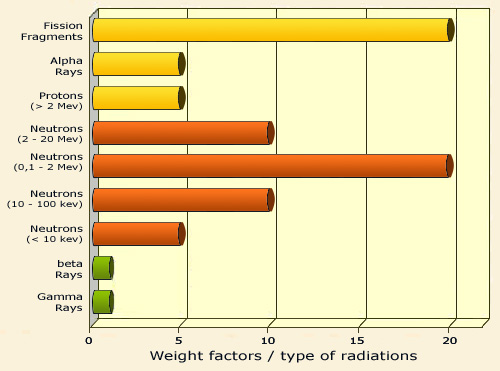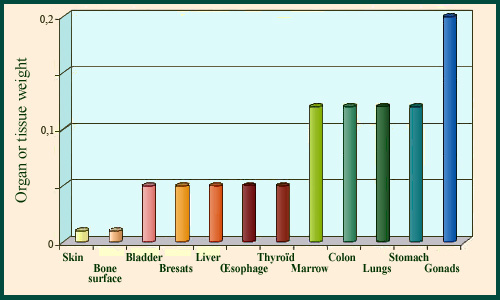Sievert (Sv) : the unit of doses for the living
The energy deposited in a living organism by radiations produces very different effects depending on the nature of the radiations and the type of tissue or organ exposed. Some parts of the body are clearly more ‘fragile’ than others. Corrective factors therefore need to be applied to obtain more relevant doses than the absorbed energy doses. The new doses are expressed in sieverts (Sv).
(Sv).

Hazards of different types of radiation:
Calculation of the biological dose takes into account the toxicity of the radiations involved through a radioactive weighting factor. There is a clear hierarchy as to how dangerous different types of radiations are to absorb or ingest, with neutrons, alpha particles being far more harmful than electrons or gamma rays. This coefficient allows to convert the amount of energy absorbed locally (in grays) to a biological dose in sieverts, the equivalent dose.
© IN2P3
The local biological dose received is calculated by multiplying the energy absorbed (in grays or Gy) by a weighting factor depending on the nature of the radiations. The resulting equivalent dose details how dangerous the radiations are to the organ or tissue in question.
This risk factor can vary from 1 for gamma rays, X-rays and beta electrons, to 10 for neutrons and even up to 20 for alpha particles. The lower danger associated with electrons, gamma and X-rays is due to their low ionising capability.

Organs sensitivities to radiations
The calculation of biological doses takes also into account the sensitivity of different body parts through tissue weighting factors. For example, reproductive organs are thought to be 20 times more sensitive than skin. These coefficients allow to estimate how toxic an exposure is by converting the amount of energy absorbed (in grays) deposited locally in body parts to an effective dose (in sieverts) that concerns the whole body.
© IN2P3
The exposure received by the whole body is expressed by a second dose, called the effective dose. The equivalent doses absorbed by each part of the body – organ or tissue – are first multiplied by a second weight which takes into account their sensitivity and biological importance. The effective dose is then calculated by summing the contributions of all the body parts.
These biological weighting factors can vary a lot, as reproductive organs such as the gonads are over twenty times more sensitive than skin. The factors are defined in such a way that exposure to weak radiation (gamma rays or electrons), leaves a biological dose in sieverts equivalent to the energy deposit expressed in grays.
This method of calculation is complex. To evaluate the doses due to ingestion or inhalation of a quantity of radionuclide, it is simpler to multiply the activity of radionuclide absorbed by a factor of dose. This factor, which converts becquerels into Sieverts reflects the radiotoxicity of the element absorbed and its journey into the body by using biological models.
If two separate doses are absorbed within a very short time span, the combined effect is the result of the combined doses. Because living matter can repair itself after small, separated bursts of radiations, the precise effects of such doses are often hard to evaluate.
The doses being dealt with are felt either over short periods, such as in the case of a medical scan or accidental exposure, or the result of chronic radiations, such as exposure to natural radioactivity.
At the moment, the maximum effective dose declared safe for the general public is of 1 mSv per year in France and 4 mSv per year in the United States. These ‘regulatory limits’ exclude radiations that are natural (2.4 mSv/year in France) or exposure due to medical diagnostics or therapies which can be much higher. These legal limits have been decreasing over recent years, as in 1992 the figures were 15 mSv per year in a large laboratory such as CERN, and 50 mSv per year in the US.
Other articles on the subject « Radioactive Doses »
Radioactive Activity Doses
Becquerel or Bq : the activity unit of a radioactive source The activity of a sample of matter wh[...]
Absorbed doses
Gray or Gy : unit of energy deposited in matter by radiation The ‘absorbed dose’ is defined as th[...]
Equivalent Dose
A local biological dose The concept of the “equivalent dose” which takes into account[...]
Effective Dose
A full-body dose, central in the field of radioprotection The “effective dose” is a b[...]
MilliSievert
A unit for low doses of radioactivity After a nuclear accident or accident of radioactivity, it i[...]
Dose Scale
A dose classification for acute exposures When dealing with exposure to radiations, what do we me[...]